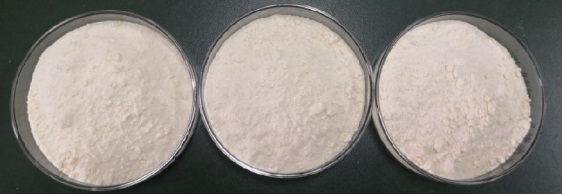Total nutrient formula food for special medical purpose for tumor patients and preparation method of total nutrient formula food
A technology for cancer patients and formula food, which is applied in the directions of food ingredients, functions of food ingredients, food ingredients containing oil, etc. It can solve the problems of not being a complete nutritional formula, not fully meeting the nutritional needs of tumor populations, and not belonging to, and improving nutrition. Adverse effects, reduced hospitalization costs, and high nutritional value
- Summary
- Abstract
- Description
- Claims
- Application Information
AI Technical Summary
Problems solved by technology
Method used
Image
Examples
Embodiment 1
[0040] A complete nutritional formula food for special medical purposes for cancer patients, 100 g of the formula food contains: 14 g of hydrolyzed whey protein, 10 g of fish collagen peptide, 16 g of vegetable fat powder, 8 g of medium chain triglycerides, 30 g of maltodextrin, 10 g of sucrose, Soybean dietary fiber 4g, inulin 3g, arginine 2.3g, glutamine 0.6g, taurine 110mg, L-carnitine 20mg, complex minerals 1.2g, multivitamins 110mg, the balance is sodium caseinate.
[0041] The 1.2g compound minerals added are: sodium citrate 400mg, potassium chloride 450mg, magnesium carbonate 50mg, ferrous sulfate 2mg, zinc gluconate 3mg, sodium selenite 20μg, copper sulfate 250μg, manganese sulfate 350μg, Sodium iodide was 40 μg, and the balance was calcium hydrogen phosphate.
[0042] The added amount of the 110mg multivitamin is: vitamin A 450μg, vitamin D 1.9μg, vitamin E 22mg, vitamin B 1 0.5mg, vitamin B 2 0.6mg, vitamin K 1 18μg, vitamin B 6 0.7mg, vitamin B 12 0.8μg, niacin...
Embodiment 2
[0050] A complete nutritional formula food for special medical purpose of tumor patients, 100g of formula food contains: 12g hydrolyzed whey protein, 12g fish collagen peptide, 18g soybean oil powder, 6g medium chain triglyceride, 34g maltodextrin, oligofructose 4g, galactooligosaccharide 2g, soybean dietary fiber 5g, polydextrose 2g, arginine 2.6g, glutamine 0.7g, taurine 100mg, L-carnitine 30mg, complex minerals 1.3g, multivitamin 64mg, more The amount is sodium caseinate.
[0051] The added amount of the 1.3g complex minerals is: sodium citrate 350mg, potassium chloride 580mg, magnesium carbonate 90mg, ferrous sulfate 6mg, zinc gluconate 7mg, sodium selenite 30μg, copper sulfate 300μg, manganese sulfate 350μg, Sodium iodide was 40 μg, and the balance was calcium hydrogen phosphate.
[0052] The added amount of the 64 mg multivitamin is: vitamin A 600 μg, vitamin D 2.5 μg, vitamin E 10 mg, vitamin B 1 0.9mg, vitamin B 2 1.2mg, vitamin K 1 25μg, vitamin B 6 0.7mg, vitami...
Embodiment 3
[0060]A complete nutritional formula food for special medical purposes for tumor patients, 100 g of formula food contains: 10 g of hydrolyzed whey protein, 14 g of fish collagen peptide, 13 g of non-dairy creamer, 11 g of soybean oil powder, 25 g of maltodextrin, 10 g of sucrose, oligomeric Fructose 3.5g, Galactooligosaccharide 1.5g, Soybean Dietary Fiber 3g, Polydextrose 2g, Resistant Dextrin 2g, Arginine 1.6g, Glutamine 0.5g, Taurine 130mg, L-Carnitine 45mg, Complex Mineral The substance is 1.34g, the multivitamin is 85mg, and the balance is sodium caseinate.
[0061] The 1.34g compound minerals added are: sodium citrate 300mg, potassium chloride 600mg, magnesium carbonate 105mg, ferrous sulfate 8mg, zinc gluconate 10mg, sodium selenite 20μg, copper sulfate 260μg, manganese sulfate 170μg, Sodium iodide is 35 μg, and the balance is calcium hydrogen phosphate.
[0062] The 85mg multivitamin addition amount is: vitamin A 700μgRE, vitamin D 5μg, vitamin E 16mgα-TE, vitamin B 1...
PUM
| Property | Measurement | Unit |
|---|---|---|
| Molecular weight | aaaaa | aaaaa |
Abstract
Description
Claims
Application Information
 Login to View More
Login to View More - R&D
- Intellectual Property
- Life Sciences
- Materials
- Tech Scout
- Unparalleled Data Quality
- Higher Quality Content
- 60% Fewer Hallucinations
Browse by: Latest US Patents, China's latest patents, Technical Efficacy Thesaurus, Application Domain, Technology Topic, Popular Technical Reports.
© 2025 PatSnap. All rights reserved.Legal|Privacy policy|Modern Slavery Act Transparency Statement|Sitemap|About US| Contact US: help@patsnap.com

